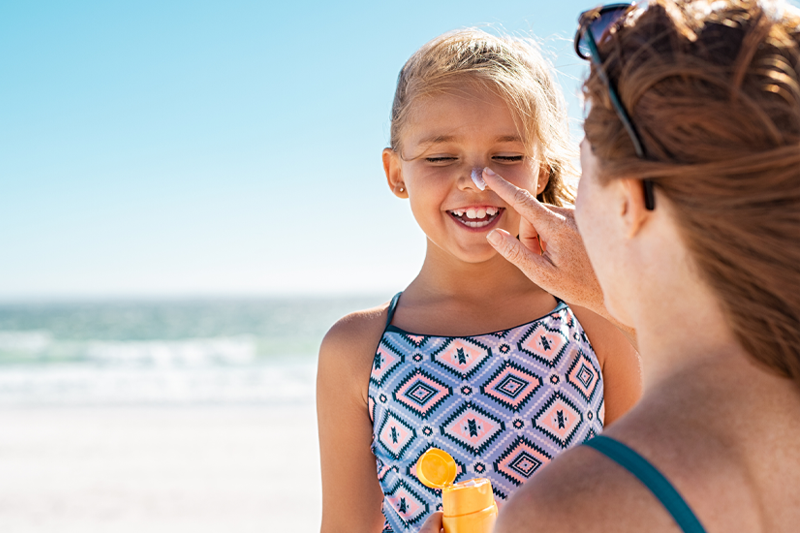Florida's nickname as the Sunshine State is well-deserved. While our state has an average of 237 sunny days per year—beating out the national average of 205—depending on where exactly you live, that number can be closer to 270 days, totaling up to an extra month of sunshine. While it can feel great to soak up all this sun, it's critical that everyone protects themselves properly from harmful rays by using sunscreen. Sunscreen can help prevent a variety of minor and major ailments from age spots and premature wrinkles to painful sunburns and skin cancer. However, there are seemingly endless options to choose from, and trying to figure out what you need can be overwhelming! Check out the information below to learn more about choosing the right type of sunscreen for your needs.
Broad Spectrum and UVA and UVB Rays
Broad spectrum sunscreen will protect you from ultraviolet A (UVA) rays which have aging effects like wrinkles, and ultraviolet B (UVB) rays which result in sunburns. Ultimately, both are harmful and can result in skin cancer. Broad spectrum provides protection against UVA and UVB by creating a barrier that absorbs or reflects the rays before they have a chance to damage your skin. Even if you're outside on a cloudy day, keep in mind UV rays can still affect you. UVA rays can go through clouds and beneath the surface of the water, and UVB rays can also damage your skin even in the fall and winter months.
Understanding SPF
SPF is the FDA's way of putting numeric value to a sunscreen's "sunburn protection factor." While you may already know a higher SPF number leads to more sun protection, you may not know that SPF only indicates a sunscreen's protection level against UVB rays as a default. However, sunscreens that pass the broad spectrum test can also provide UVA protection. Simply look for a note that says "Broad Spectrum SPF [value]"on the label. Unfortunately, no sunscreen can filter out 100% of UVB rays. While fair-skinned people naturally need a higher SPF, everyone should consider additional protection methods like sunglasses, wide-brimmed hats, breathable long sleeve shirts, and sitting in shady areas.
Chemical vs. Physical and When to Reapply
As mentioned before, sunscreen protects your skin by either absorbing (chemical) or deflecting (physical) UV rays.
Chemical sunscreens are usually thinner consistency so it spreads more easily on the skin, therefore less product is needed overall. However, you must wait 20 minutes for it to become effective, it can also be troublesome for people with sensitive skin (especially the higher the SPF is).
Physical sunscreens are naturally broad spectrum and will offer immediate protection with a longer shelf life. Frequent and thorough application is needed more often, though, as they can wipe off easier in water or after sweating. For people with darker complexions, some types can also leave a white film or cast.
Both types have different active ingredients which can be absorbed into your body, so it's important to review the ingredients before applying. For instance, if a label says "for sensitive skin," it often means that the sunscreen won't have some active ingredients found in chemical sunscreens that are more likely to irritate skin.
Once you put on sunscreen, it'll only last so long against UV rays, sweat, and water. Be sure you're reapplying sunscreen every two hours at least, especially after you towel off or have been in the water. Remember, there's no such thing as "waterproof" sunscreen, and UVA rays can still affect you while you're splashing around. If you're using water-resistant sunscreen, reapply every 40–80 minutes.
Additional Factors to Consider
- The American Academy of Dermatology recommends avoiding using sunscreen babies who are younger than 6 months. If they're 6 months or older, look for a sunscreen that contains zinc oxide or titanium dioxide, which is better for sensitive baby skin.
- According to the FDA, sunscreen should never be left out in direct sunlight. Avoid damaging your sunscreen by keeping it in a cool area, or wrapped up in a towel for some shade at minimum.
- Similar to water-resistant sunscreen, sunscreen labeled "Sport" should be reapplied every 40–80 minutes.
- The American Academy of Dermatology also suggests avoiding sunscreen with insect repellent. That's because while sunscreen should be applied frequently, ingredients in insect repellent should only be used sparingly.
- The FDA requires all sunscreens to come with an expiration date, so be sure to check the date on your bottle or tube to ensure you're getting maximum protection.
American Academy of Dermatology Association. (n.d.). How to Decode Sunscreen Labels. AAD.org. https://www.aad.org/public/everyday-care/sun-protection/sunscreen/understand-sunscreen-labels
Holman, T. (2016, August 10). Can You Get a Sunburn on a Cloudy Day? And Other Less-Obvious Sun Safety Scenarios. DignityHealth.org. https://www.dignityhealth.org/articles/can-you-get-a-sunburn-on-a-cloudy-day-and-other-less-obvious-sun-safety-scenarios
U.S. Food and Drug Administration. (2010, August 29). Sunscreen: How to Help Protect Your Skin from the Sun. FDA.gov. https://www.fda.gov/drugs/understanding-over-counter-medicines/sunscreen-how-help-protect-your-skin-sun
Winkler, V. (2015, October 12). These 10 Cities In Florida Have The Best Weather In The Entire State. OnlyInYourState.com. https://www.onlyinyourstate.com/florida/best-weather-fl/
